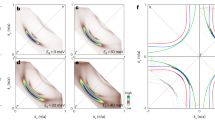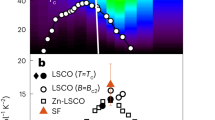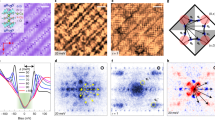Abstract
The phase diagram of high-temperature superconductors is still to be understood1. In the low-carrier-doping regime, a loss of spectral weight in the electronic excitation spectrum—the so-called pseudogap—is observed above the superconducting temperature Tc, and below a characteristic temperature T* (ref. 2). First observed in the spin channel by NMR measurements, the pseudogap has also been observed in the charge channel by scanning probe microscopy and photoemission experiments, for instance2. An important issue to address is whether this phenomenon is related to superconductivity or to a competing ‘hidden’ order. In the superconductivity case, it has been suggested that superconducting pairing fluctuations may be responsible, but this view remains to be tested experimentally. Here, we have designed a Josephson-like experiment to probe directly the fluctuating pairs in the normal state. We show that fluctuations survive only in a restricted range of temperature above Tc, well below T*, and therefore cannot explain the opening of the pseudogap at higher temperature.
This is a preview of subscription content, access via your institution
Access options
Subscribe to this journal
Receive 12 print issues and online access
$259.00 per year
only $21.58 per issue
Buy this article
- Purchase on SpringerLink
- Instant access to full article PDF
Prices may be subject to local taxes which are calculated during checkout




Similar content being viewed by others
References
Norman, M. R. & Pepin, C. The electronic nature of high temperature cuprate superconductors. Rep. Prog. Phys. 66, 1547–1610 (2003).
Timusk, T. & Statt, B. The pseudogap in high-temperature superconductors: An experimental survey. Rep. Prog. Phys. 62, 61–122 (1999).
Ding, H. et al. Spectroscopic evidence for a pseudogap in the normal state of underdoped high-Tc superconductors. Nature 382, 51–54 (1996).
Norman, M. R. et al. Destruction of the Fermi surface in underdoped high-Tc superconductors. Nature 392, 157–160 (1998).
Renner, Ch., Revaz, B., Genoud, J.-Y., Kadowaki, K. & Fischer, Ø. Pseudogap precursor of the superconducting gap in under- and overdoped Bi2Sr2CaCu2O8+δ . Phys. Rev. Lett. 80, 149–152 (1998).
Emery, V. J. & Kivelson, S. A. Importance of phase fluctuations in superconductors with small superfluid density. Nature 374, 434–437 (1995).
Randeria, M. in Proc, Int. School of Physics ‘Enrico Fermi’ Course CXXXVI on High Temperature Superconductors (eds Iadonisi, G., Schrieffer, J. R. & Chiafalo, M. L.) 53–75 (IOS Press, Amsterdam, 1998).
Ferrell, R. A. Fluctuations and the superconducting phase transition : II. Onset of the Josephson tunneling and paraconductivity of a junction. Low. Temp. Phys 1, 423–442 (1969).
Scalapino, D. J. Pair tunneling as a probe of fluctuations in superconductors. Phys. Rev. Lett. 24, 1052–1055 (1970).
Anderson, J. T. & Goldman, A. M. Experimental determination of the pair susceptibility of a superconductor. Phys. Rev. Lett. 25, 743–747 (1970).
Janko, B., Kosztin, I., Levin, K., Norman, M. R. & Scalapino, D. J. Incoherent pair tunneling as a probe of the cuprate pseudogap. Phys. Rev. Lett. 82, 4304–4307 (1999).
Barone, A. & Patterno, G. Physics and Applications of the Josephson Effect (Wiley–Intersciences, New York, 1982).
Golubov, A. A. et al. Resonant tunneling in Y(Dy)Ba2Cu3O7−δ/PrBa2Cu3−xGaxO7−δ/Y(Dy)Ba2Cu3O7−δ ramp type Josephson junctions. Physica C 235–240, 3261–3262 (1994).
Bari, M. A. C-axis tunneling in YBa2Cu3O7−δ trilayer junctions with PrBa2Cu3−xGaxO7−δ barrier. Physica C 256, 227–235 (1996).
Devyatov, I. A. & Kupriyanov, M. Yu. Resonant tunneling through SIS junctions of arbitrary size. Zh. Eksp. Teor. Fiz. 112, 342–352 (1997); JETP Lett. 85, 189–194 (1997).
Yoshida, J. & Nagano, T. Tunneling and hopping conduction via localised states in thin PrBa2Cu3O7−x barriers. Phys. Rev. B 55, 11860–11871 (1997).
Glazman, L. I. & Matveev, K. A. Inelastic tunnelling across thin amorphous films. Sov. Phys. JETP 67, 1276–1282 (1988).
Kadin, A. M. & Goldman, A. M. Pair-field susceptibility and superconducting tunneling: A macroscopic approach. Phys. Rev. B 25, 6701–6710 (1982).
Devyatov, I. A. & Kupriyanov, M. Yu. Current–voltage characteristics of a SIS structures with localised states in the material of the barrier layer. Zh. Eksp. Teor. Fiz. 114, 687–699 (1998); JETP Lett. 87, 375–381 (1998).
Takenaka, K., Mizuhashi, K., Takagi, H. & Uchida, S. Interplane charge transport in YBa2Cu3O7−y: Spin-gap effect on in-plane and out-of-plane resistivity. Phys. Rev. B 50, 6534 (1994).
Corson, J., Mallozzi, R., Orenstein, J. J. N., Eckstein, J. N. & Bozovic, I. Vanishing of phase coherence in underdoped Bi2Sr2CaCu2O8+δ . Nature 398, 221–223 (1999).
Xu, Z. A. et al. Vortex-like excitations and the onset of superconducting phase fluctuation in underdoped La2−xSrxCuO4 . Nature 406, 486–488 (2000).
Wang, Y. et al. Onset of the vortex-like Nernst signal above Tc in La2−xSrxCuO4 and Bi2Sr2−yLayCuO6 . Phys. Rev. B 64, 224519 (2001).
Rullier-Albenque, F. et al. Nernst effect and disorder in the normal state of high-Tc cuprates. Phys.Rev. Lett. 96, 067002 (2006).
Ussishkin, I., Sondhi, S. L. & Huse, D. A. Gaussian superconducting fluctuations, thermal transport, and the Nernst effect. Phys. Rev. Lett. 89, 287001 (2002).
Pourret, A. et al. Observation of the Nernst signal generated by fluctuating Cooper pairs. Nature Phys. 2, 683–686 (2006).
Carrington, A., Mackenzie, A. P., Lin, C. T. & Cooper, J. R. Temperature dependence of the Hall angle in single-crystal YBa2(Cu1−xCox)3O7−δ . Phys. Rev. Lett. 69, 2855–2858 (1992).
Bergeal, N. et al. Using ion irradiation to make high-Tc Josephson junctions. J. Appl. Phys. 102, 083903 (2007).
Acknowledgements
We acknowledge M. Grilli, S. Caprara, C. Castellani and C. Di Castro for stimulating discussions. We also thank P. Monod, O. Kaitasov and C. Dupuis.
Author information
Authors and Affiliations
Corresponding authors
Rights and permissions
About this article
Cite this article
Bergeal, N., Lesueur, J., Aprili, M. et al. Pairing fluctuations in the pseudogap state of copper-oxide superconductors probed by the Josephson effect. Nature Phys 4, 608–611 (2008). https://doi.org/10.1038/nphys1017
Received:
Accepted:
Published:
Issue date:
DOI: https://doi.org/10.1038/nphys1017
This article is cited by
-
Absence of a BCS-BEC crossover in the cuprate superconductors
npj Quantum Materials (2023)
-
Fractionalizing a Local Pair Density Wave: a Good “Recipe” for Opening a Pseudo-gap
Journal of Superconductivity and Novel Magnetism (2020)
-
Pairfield fluctuations of a 2D Hubbard model
npj Quantum Materials (2019)
-
Local particle-hole pair excitations by SU(2) symmetry fluctuations
Scientific Reports (2017)
-
Quasi-particles ultrafastly releasing kink bosons to form Fermi arcs in a cuprate superconductor
Scientific Reports (2016)



